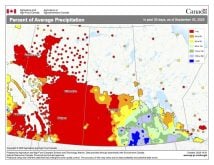It might be time to take a break from our discussions on severe summer weather but then again, this topic does fit into severe summer weather because it is about heat, humidity and rain.
It seems this is going to be the year where every cloud or thunderstorm that comes along has potential to drop a significant amount of rain. After dealing with a wet April-to-June period, we entered what can be the wettest month of year with hopes that maybe, just maybe, areas of southern and central Manitoba that do not need more rain will get a reprieve.
For several locations, those thoughts came crashing down on July 19 when an upper low brought several rounds of thunderstorms.
Read Also

Farmer gift idea: How about a weather station?
The 2025 holiday season is looming, and a home weather station might make a great Christmas gift for farmers
After a couple of days of intense heat and humidity (more on that later), an area of surface low pressure tracked through our region early July 19. This low, tapping into the available moisture and instability, generated a large cluster of severe thunderstorms that brought significant rainfall to some areas, with the southern Interlake seeing the worst.
Later that same day, an upper low, trailing the surface low, tracked through and was able to capitalize on the leftover humidity and daytime heating to create a second round of severe thunderstorms. I checked on rainfall amounts late that day and the table here shows some of the larger totals.
Looking at all the agricultural stations across Manitoba, I could not find a single station that reported less than 20 mm, with most locations reporting between 20 and 50 mm of rain. While some areas welcomed it, most struggled as already-waterlogged soils were not able to absorb more than about 20 mm before flooding occurred.
All this rain and humidity led to someone asking, “will hot humid days almost always be followed by significant rains?” While this is often the case, high humidity does not always mean significant rainfall.
For large amounts of rainfall, we need a lot of available moisture in the atmosphere over a large area. This moisture also needs to be deep. That is, a large vertical portion of the atmosphere must have a lot of moisture or high humidity. We could have high surface humidity but dry air above us. This scenario would likely not lead to rainfall.
For this last storm system, the humidity was deep and widespread. Add to this an area of low pressure to provide lift, and that humidity was able to convert into rainfall.
Other hot topics
Let’s consider the extreme humidity of July 18. If you are a regular reader, you know that the best way to measure humidity is by looking at the dewpoint.
Dewpoints on July 18 hit unconfirmed record highs across a large portion of southern Manitoba. Winnipeg recorded a dewpoint of 26.3 C which, if confirmed, would break the record of 26.1 C set in 1966. My own weather station recorded a dewpoint of 28.2 C that day, which is close to the Canadian record-high dewpoint of 30 C set in Carman, Man. in 2007.
Air with a dewpoint of 20 C holds about 17 grams of water per cubic metre. Bump the dewpoint to 30 C, and that same cubic metre now holds 30 grams, or almost double the amount of water.
Now, onto the third hot topic this week: record-breaking heat across the United Kingdom. That country has just experienced its hottest heatwave on record. At nearly the same time we were experiencing our extreme heat, the U.K. experienced what was thankfully a relatively short-lived heatwave that saw temperatures crush the all-time record highs for that region.
All-time records for a nation, when beaten, are usually just beaten by a few 10ths of a degree. This seems to be changing. We saw this when the Canadian record of 45 C was smashed last year in Lytton with a new all-time high of 49.6 C. In the U.K., the all-time heat record was 38.7 C, but that was broken when London hit 40.2 C, making it the first 40-plus C day ever recorded in that nation. Just as significant was that 29 sites across the U.K. broke the previous national record of 38.7 C on that day.
It should be noted that the U.K. probably has the longest and most reliable temperature records, with many sites going back 200 years. I think I should also point out that the U.K. heat, and our humidity, were not caused by some unique, once-in-50- or -100-year weather event.
While several things had to come together for these events to occur, they were not strange weather circumstances. They were weather patterns that would not normally create these types of temperatures or humidities, yet they did.
For those who still think climate warming is a joke or a conspiracy, I am not sure how much more evidence needs to be provided.
For my next article, my timing will be too far off to do the monthly weather roundup, so instead, we will look at hail – and no, just because we discuss it does not mean it will happen.
















